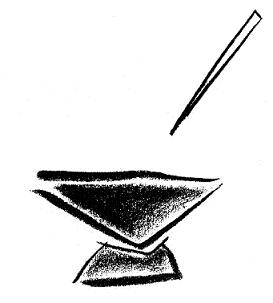
Stirfried vegetables over rice are one of the foundations of a vegetarian diet: a colourful, nourishing, and speedy meal that utilizes the vegetables you have on hand. Cashews add protein, texture, and richness.
SERVES 4
2 T. sunflower oil
2 T. toasted sesame oil
4 cloves garlic, minced
1˝ fresh ginger, minced
1 small dried hot chili
1 medium onion, cut into cresents
1 large carrot, peeled and sliced on the diagonal
2 stalks celery, sliced on the diagonal
Heat oil in a large wok or skillet. When oil is very hot, but not smoking, add ginger, garlic, and chili. Stirfry for 30 seconds; add onion, carrot, and celery. Stirring frequently, cook over medium high heat for 3 to 5 minutes until vegetables are barely tender.
1 red or green bell pepper, julienned
1 bunch green onions, cut in 1˝ lengths
8 to 10 mushrooms, sliced
2 cups snow peas or shredded cabbage or bok choy
1 cup cashews, roasted or raw
Add peppers, green onions, mushrooms, cabbage, and cashews to the onions. Continue to stirfry for another 3 minutes.
1 cup bean sprouts
¼ cup tamari
Add sprouts and tamari; toss and stirfry for one more minute. Remove from heat and serve immediately over rice or bulghar wheat.
HOW TO STIRFRY
Stirfrying is a method of cooking over high heat, frying food in a small amount of oil very quickly while stirring almost constantly. Because the food cooks so rapidly, you need to have all the ingredients prepared before you begin. Cut the vegetables in attractive shapes, matchsticks or triangles or crescents – this makes the dish much more appealing. (Pretty food tastes better.) Quick cooking over high heat is the secret to success; the vegetables will retain their colour and most of their crispness.
Add or substitute almost any vegetable you have on hand: zucchini, peeled winter squash, eggplant, green beans, snow peas, shiitake mushrooms, spinach, kale, or canned Chinese specialties such as bamboo shoots, water chestnuts, or baby corn. Walnuts, almonds, cashews, or sesame seeds add protein (I prefer the flavour of roasted nuts, but raw nuts are acceptable). Cook cubes of tempeh or pressed, drained tofu before you add the vegetables: stirfry them separately, remove from the wok and reserve. Add them again at the end, tossing gently to prevent crumbling.
Some vegetables will cook more quickly than others. Arrange the prepared ingredients in separate bowls or in mounds on a tray near the stove, in the order that you will cook them. Onions, carrots, celery, and winter squash take the longest time to cook, so they go into the wok first. Peppers, sweet potatoes, mushrooms, zucchini, water chestnuts, nuts, and baby corn should be added next. Add leafy greens and bean sprouts at the last minute as they take very little cooking.
Garlic and ginger are the mainstays of an Oriental stirfry, but you can increase or decrease amounts to suit your personal taste. While stirfrying, add a pinch of nutmeg or a generous handful of fresh cilantro for flavour; or sprinkle on a combination of spices called Chinese Five Spice, or star anise, one of its component spices. You can omit the tamari at the end and toss the vegetables with sweet and sour sauce or hoisin, a rich, dark sauce found in Oriental shops. Or drain off any liquid from the vegetables into a small skillet, stir in 1 T. cornstarch dissolved in 2 T. water, ¼ cup orange juice, 1 t. honey and more tamari to taste. Heat until slightly thickened, stirring constantly, and pour back over vegetables. Serve hot.
A generous portion of stirfried vegetables over rice, bulghar wheat, couscous, or Japanese style noodles (udon or soba) can be a meal in itself. Serve stirfried vegetables as a side dish with marinated baked tofu. Pass extra tamari at the table for people to add, if desired. Chopsticks are especially appropriate when eating stirfried vegetables.
